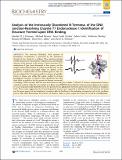Analysis of the intrinsically disordered N-terminus of the DNA junction-resolving enzyme T7 endonuclease I : identification of structure formed upon DNA binding
Abstract
The four-way (Holliday) DNA junction of homologous recombination is processed by the symmetrical cleavage of two strands by a nuclease. These junction-resolving enzymes bind to four-way junctions in dimeric form, distorting the structure of the junction in the process. Crystal structures of T7 endonuclease I have been determined as free protein, and the complex with a DNA junction. In neither crystal structure was the N-terminal 16-amino acid peptide visible, yet deletion of this peptide has a marked effect on the resolution process. Here we have investigated the N-terminal peptide by inclusion of spin-label probes at unique sites within this region, studied by electron paramagnetic resonance. Continuous wave experiments show that these labels are mobile in the free protein but become constrained on binding a DNA junction, with the main interaction occurring for residues 7-10 and 12. Distance measurements between equivalent positions within the two peptides of a dimer using PELDOR showed that the intermonomeric distances for residues 2-12 are long and broadly distributed in the free protein but are significantly shortened and become more defined on binding to DNA. These results suggest that the N-terminal peptides become more organized on binding to the DNA junction and nestle into the minor grooves at the branchpoint, consistent with the biochemical data indicating an important role in the resolution process. This study demonstrates the presence of structure within a protein region that cannot be viewed by crystallography.
Citation
Freeman , A D J , Stevens , M , Declais , A C , Leahy , A , Mackay , K , El Mkami , H , Lilley , D M J & Norman , D G 2016 , ' Analysis of the intrinsically disordered N-terminus of the DNA junction-resolving enzyme T7 endonuclease I : identification of structure formed upon DNA binding ' , Biochemistry , vol. 55 , no. 30 , pp. 4166-4172 . https://doi.org/10.1021/acs.biochem.6b00242
Publication
Biochemistry
Status
Peer reviewed
ISSN
0006-2960Type
Journal article
Description
This work was supported by grants from The Engineering and Physical Sciences Research Council (EPSRC), Basic Technology EP/F039034/1, The Wellcome Trust, 099149/Z/12/Z, and Cancer Research UK (CRUK), C28/A18604.Collections
Items in the St Andrews Research Repository are protected by copyright, with all rights reserved, unless otherwise indicated.

